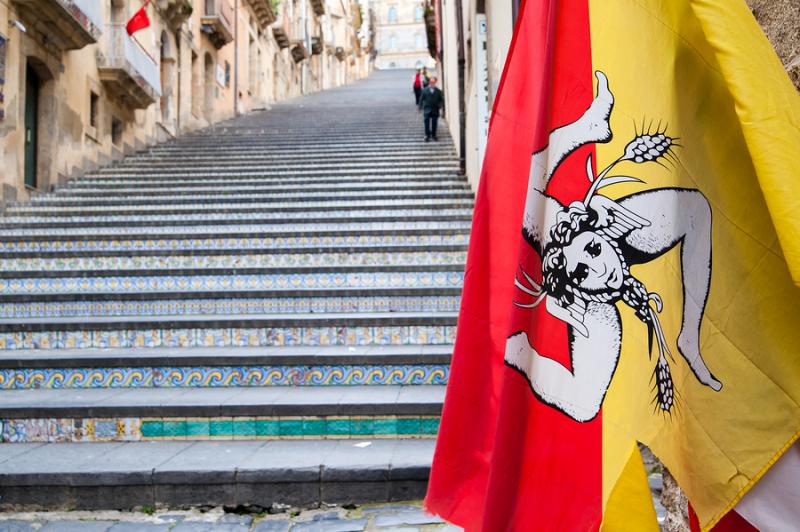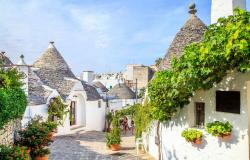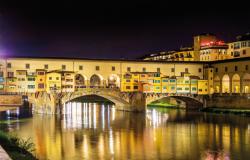What Does the Symbol of Sicily Mean?
ITA:

Use player to listen to Italian version
If you’ve traveled to Sicily, you’ve likely seen, on flags, ceramics and souvenirs, a strange-looking representation of a female head with three legs attached to it, flexed to form a triangle.
That’s the symbol of Sicily, adopted by the island many centuries ago, when it was dominated by the Greeks, now used in the official Sicilian flag.
The symbol is known as Trinacria, a Greek word that means ‘three pointed;’ it recalls the shape of the island, which resembles a triangle. Trinacria was the earliest known name of the island of Sicily.
The head refers to Greek mythology, it is said to be Medusa, a gorgon (monstrous creature) with a head of snakes, a beautiful woman seducing men who, upon looking at her, were turned into stone. In the past, it was customary to place a trinacria behind the home’s door as a symbol of protection for the house - the Medusa would have turned to stone whoever wanted to hurt the family living inside.
The hair on the head of the gorgon is a snake intertwined with stalks of wheat, to which three legs bent at the knee are attached. The arrangement of the three legs refers to Eastern religious symbolism. The three legs represent the three capes of the island of Sicily: Peloro (north-east), Passero (south), and Lilibeo (west), which form the three points of a triangle.
The three stalks of wheat were added in Roman times, when Sicily was a major wheat provider of the Roman empire; overall, they symbolize the fertility and prosperity of the region.
The oldest known representation of the Trinacria is a terracotta vase housed in the Archeological Museum of Agrigento.
Se hai viaggiato in Sicilia, è probabile che tu abbia visto, su bandiere, ceramiche e souvenir, una rappresentazione dall'aspetto strano di una testa femminile a cui sono attaccate tre gambe, flesse a formare un triangolo.
Questo è il simbolo della Sicilia, adottato dall'isola molti secoli fa, quando era dominata dai Greci, ed ora utilizzato sulla bandiera ufficiale siciliana.
Il simbolo è noto come Trinacria, una parola greca che significa ‘tre punte’, in riferimento alla forma dell'isola, che ricorda un triangolo. Trinacria fu il primo nome dato all'isola.
La testa rientra nell’ambito della mitologia greca, si dice che sia Medusa, una gorgone (creatura mostruosa) con testa di serpenti, una bellissima donna che seduce gli uomini i quali, guardandola, venivano trasformati in pietra. In passato, era consuetudine posizionare una trinacria dietro la porta di casa come simbolo di protezione: la Medusa avrebbe pietrificato chiunque volesse fare del male alla famiglia che viveva al suo interno.
I capelli sulla testa della gorgone sono un serpente intrecciato con spighe di grano, a cui sono attaccate tre gambe flesse al ginocchio. La disposizione delle tre gambe si riferisce al simbolismo religioso orientale. Le tre gambe rappresentano i tre promontori dell'isola: Peloro (nord-est), Passero (sud) e Lilibeo (ovest), che formano le tre punte di un triangolo.
Le tre spighe di grano furono aggiunte in epoca romana, quando la Sicilia era uno dei maggiori granai dell'impero romano; nel complesso simboleggiano la fertilità e la prosperità del territorio.
La più antica rappresentazione conosciuta della Trinacria è un vaso in terracotta conservato nel Museo Archeologico di Agrigento.











